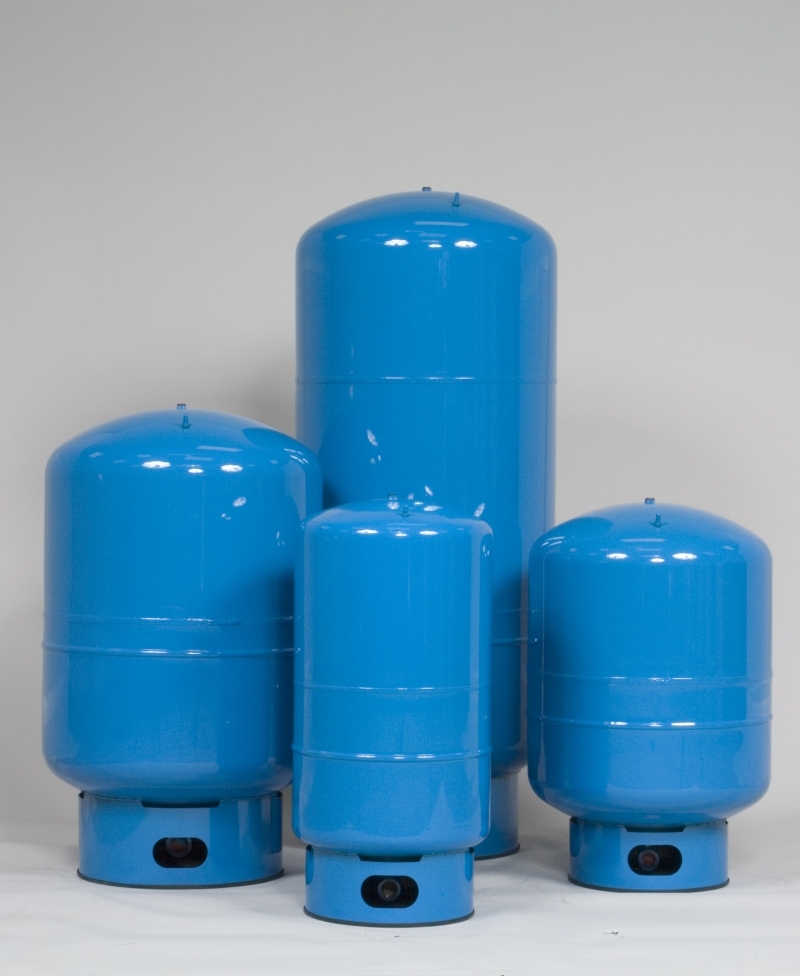
An expansion tank can help your water heater last longer and it may even be required in many areas. Many counties require a plumbing permit for installing a water heater so you can ask the building and safety department if an expansion tank is also required. As long as you have a place for an expansion tank on top of your water heater they are easy to install. Even if an expansion tank is not required in your area it can be a good idea to install one to prevent damage from thermal expansion. Installing an expansion tank is a moderate do it yourself project. If you are installing a new water heater yourself then it’s the best to install the expansion tank at the same time.
Elbi Bladder Tank
Parts required: All you will need (on top of the requirements for a normal water heater installation) is a ¾ x 4” galvanized nipple, a galvanized ¾” tee, a ¾” galvanized elbow, a short 2” galvanized nipple, pipe joint compound, and plumber's tape.

New Water Heater Installation: There are plenty of ways to plumb the expansion tank into the water heater, but the easiest method we have seen is with Galvanized pipe. It is inexpensive and easy to install. Some water heaters come with the nipples already in the water heater for the hot and cold water supplies. If these are not already in and tight then you will have to install them first. The expansion tank can go on the hot or cold side but it’s a good idea to check with your building department and ask which side they want it on because we have heard arguments for both and the requirements can go either way. When tightening the galvanized joints make sure to use two large pliers or two pipe wrenches because the joints will need to be tight. One wrench will be used to hold against the pipe you are tightening and the other is used to tighten the pipe or fitting.

Zilmet is one of the oldest and largest expansion tank manufacturer in the world. Established in italy in 1962, Zilmet is an international manufacturer of quality expansion vessels, pressure tanks and plate heat exchangers with several branches and worldwide distribution. Therm-X-Trol expansion tanks are designed to control pressure in commercial closed, potable hot water systems. Available in diaphragm, partial acceptance bladder and full acceptance bladder designs, these tanks range in size from 2 gallons (7.6 liters) to 528 gallons (2,000 liters). Open Expansion Tanks. Required volume of an open expansion tank can be expressed as. V et = k V w (v 1 / v 0) - 1 (2) V et = required expansion tank volume (gallon, liter) k = safety factor (approximately 2 is common) V w = water volume in the system (gallon, liter).
Elbi Pressure Tanks
- Install the galvanized tee on top of the water heater. Make sure to put plumber's tape and pipe joint compound on the nipple coming out of the water heater. Tighten the tee and make sure to face it in the direction you want the tank to go. You can always swing it a little once it is in place, but get it close to where you need it to make it easier.
- Next prepare the long nipple with plumber's tape on both ends. Put a little pipe joint compound over the plumber's tape. To make things easier tighten the elbow onto the nipple on the ground. Once it is tight then you can screw just the one side into the tee. When it is tight, make sure that it is facing straight up.
- Prep the threads on the expansion tank with plumber's tape and a brush of pipe joint compound. Now screw the expansion tank into the elbow. Go until the expansion tank is tight, it does not really matter which direction it ends up on.
- Last is nipple on top of the tee. Only the end going into the tee needs plumber's tape and pipe joint compound. Tighten the nipple into the tee. Now the water heater flex line will connect to the nipple. Sometimes the flex line will need to be flexed around to fit properly. A long flex line can even make a loop if necessary to make the connection.
Amtrol
Existing Water Heater Installation: Make sure there is plenty of room above the hot or cold side of the water heater for the expansion tank. The main difference when installing an expansion tank to an existing water heater is that you are removing the flex line first and installing the tee where it made the connection. Things can get a little tight and you may need to use a longer flex line so you can do a big loop or even a shorter water heater flex line if it makes it easier. It is often a good idea to change that flex line either way because they rarely go back without trouble especially when a change is made.